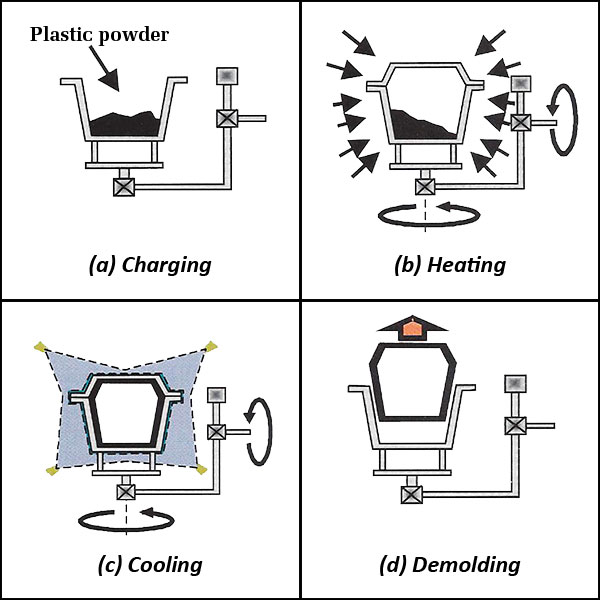CAPABILITIES

Rotational molding, also known as rotomolding, is a plastics molding technology which is ideal for making hollow articles. It is a casting technic but unlike most other plastics processes there is no pressure involved. Molds for the process are relativelyinexpensive as they do not have to withstand pressure and therefore relatively short production runs can be made very economically.
Rotomolding is used to make a very diverse range of products. The process offers the product designer exceptional freedom as just about any shape can be produced. There is almost no limit to the size of moldings and there are literally thousands of applications.
The Process
The concept of rotational molding is very simple. A plastic material, normally in powder form is placed into a hollow mold, usually made from cast aluminium or fabricated from sheet steel. The mold is closed and rotated slowly on two axis. The mold is then heated in an oven whilst rotating and the polymer gradually melts and ‘lays-up’ on the inside of the mold. Once the polymer powder has fully melted the mold is moved to a cooling station and cooled usually with air and sometimes a fine mist of water. As the mold cools the part solidifies. When the material has finally cooled sufficiently to release away from the mold surface the process is stopped and the product is taken out of the mold (de-molded).
Whilst the concept of rotational molding is extremely simple anyone who has ever been involved in the process will tell you that it is in fact extremely complicated. It is a casting process and there is normally no pressure involved which means that the material cannot be controlled in the same way as high pressure processes such as injection molding. There are many variables that can affect production and the end product such as ambient temperature and humidity, type of mold, material specification and powder quality.

Materials
Today the industry is heavily dependent on Polyethylene (PE) and 97% of rotomolded products are made from this material. Polyethylene is a versatile, easily moldable and readily available polymer which has come to dominate the process. Rotomolding is a casting technique in which powder is nearly always used rather than granules, meaning the material must be ground. Polyethylene is relatively easy to grind at ambient temperatures. The development of other polymers has been hindered by the fact that the process is relatively long and therefore aggressive on polymers, however there is some usage of PVC (usually in liquid plastisol form), Polypropylene and Polyamide (PA6, PA11 & PA12). Many of these non-Polyethylene materials are difficult to grind and most need to be made into powder using cryogenic grinding – that is freeze grinding, which is a costlier process. There is a welcome increase in R&D to expand the range of materials available to the industry.
Key advantages
Rotomolding has several unique characteristics and advantages compared to other molding processes.
• Low tooling costs. As this is a casting process there is no pressure. This means molds are inexpensive and low volume can be economic. If you have a great idea for a new product but don’t know how many you’ll sell or simply want a low volume production
• Run, rotomolding’s low initial investment makes it particularly attractive.
• It’s easy to make complicated shapes. Rotomolding readily accommodates production complexities such as stiffening ribs, molded inserts and different surface textures.
• Uniform wall thickness. Rotomolding achieves consistent wall thickness with corners tending to be thicker. This increases product strength and integrity. Other processes such as blow molding stretch the molten material at corners or sharp edges creating potential thin spots and weaknesses.
• Rotational molding machine costs are low compared to other processes and the investment required is small. There is great production flexibility with the process.
• There is almost no limit to the size of products and several different products can be molded at the same time.
Products
This exceptionally versatile technology can produce a remarkable range of moldings. There are thousands of products that are rotomolded used in a multitude of sectors. Key areas include:
• Tanks for storing water and chemicals – up to 50,000 litres
• Material handling products such as containers, crates, pallets and insulated fish and cooler boxes.
• Environmental products which include litter bins, road cones, bollards, traffic dividers and road signs.
• Floats, buoys and pontoons.
• Automotive products such as truck mudguards, ducting, diesel fuel tanks, toolboxes and tractor dashboards.
• Kayaks, canoes and boats
• Products for the outdoors such as garden planters, water butts and furniture.
• Toys and playground equipment.


